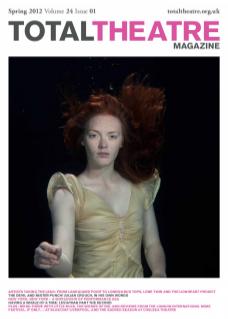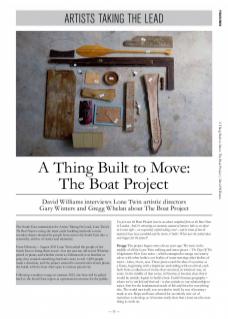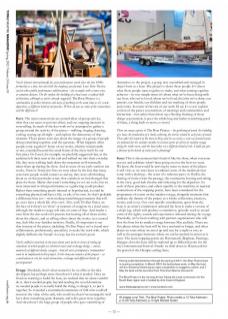From February – August 2011 Lone Twin asked the people of the South East to bring them wood – but not just any old wood. Whether pencil or piano, and whether exotic as Zebrawood or as familiar as pine, they wanted something that had a story to tell. 1,200 people made a donation, and the project entered its second and current phase: the build, with the boat shed open to curious passers-by.
Following a maiden voyage in summer 2012, the boat will be gifted back to the South East region as a permanent resource for the public.
I’ve just seen the Boat Project boat in an almost completed form at the Boat Show in London. And it’s attracting an enormous amount of interest, both as an object in its own right – an exquisitely crafted sailing vessel – and in terms of how its materials have been assembled and the stories it ‘holds’. What were the initial ideas and triggers for the project?
Gregg: The project began some eleven years ago. We were in the middle of all the Lone Twin walking and water pieces – The Days Of The Sledgehammer Have Gone series – which attempted to merge our watery selves with other bodies: our bodies of water meeting other bodies of water – lakes, rivers, seas. Those pieces used the idea of a journey as a frame, beginning with a departure and ending with an arrival, each built from a collection of stories that occurred, in whatever way, en route. In the middle of that series, in Norway, it became clear that it would be entirely logical to build a boat. Earth’s human geography – where we’ve settled and thrived – is due entirely to our relationship to water, first for the fundamental needs of life and then for everything else. The world met itself, was revealed to itself, by way of journeys made at sea. Ships and boats allowed for an entirely new set of narratives to develop, so it became really clear that a boat was the next thing to work on.
You’re known internationally for your performance work since the late 1990s: primarily as a duo, but also with the company you formed, Lone Twin Theatre, and in other public performance collaborations – for example with a town crier, or amateur dancers. On the surface the building of a boat seems a radical shift of direction, although as you’ve already suggested, The Boat Project is a continuation of earlier interests and ways of working at the same time as it’s a new departure, a different kind of art practice. Where do you see some of the connections, and the differences?
Gary: The main connections are around ideas of group activity, what that can cause or put into effect, and our ongoing interests in storytelling. In much of the duo work we’ve attempted to gather a group around the activity of the pieces – walking, singing, dancing, cycling, staying up all night – and explore the democracy of that moment. Those pieces were also about the image of a group of people doing something together, and the question, ‘What happens when people come together?’ Some of our works, whether intentionally or not, extended beyond the usual frame of the show itself. In our first piece On Everest, for example, we playfully suggested that, as the audience left their seats at the end and walked out into their everyday life, they were walking back down the mountain we’d notionally taken them up during the show. And in some of our early outdoor site works, Totem or Twenty-four Four, we were taken by the fact that many years later people would contact us and say they were still thinking about us on that particular street, that somehow we had changed that place for them. Maybe that wasn’t something we set out to do, but we were interested in what performance or a gathering could produce. Rather than something purely internal or hypothetical, it could be something physical and have a life, or job, of its own. So that’s probably a difference here too – we’re making something permanent that will go on to have a whole life of its own. Also, with The Boat Project, on the face of it there’s no ‘show’ or moment of congress in a usual sense, although the maiden voyage will take on some of that. And maybe a tone from the duo work isn’t present, but hearing all of those stories about the objects, and us telling others about the stories, in a curated way, feels like very familiar territory. Finally, it’s important to say that in many of the pieces, including The Boat Project, we’ve found new collaborators, professionals, specialists, to make the work with, which slightly diffracts the ‘brand’ in a way, but for us that’s good.
You’ve talked extensively in the past about your work in terms of setting up situations in which people are invited to meet and exchange things – stories, materials of different kinds, energies. And all sorts of temporary ‘communities’ seem to be implicated in this project. Is this how you conceive of the project – as a mechanism or site for social interaction, exchange and different kinds of participation?
Gregg: Absolutely, that’s what seemed to be on offer as the idea developed, but perhaps more than that it’s what it needed. Once we fixed on wanting to build the boat, we realised that we alone couldn’t do it, that it needed people; beyond needing the wood donations we needed people to actually build the thing, to design it, to put it together. So it needed a committed community of folk who could all invest in the value of the task, who could see that if we managed it we’d have done something quite dramatic and told a great story together. And then there’s the huge group of people who gave something of themselves to the project, a group now assembled and arranged in object form as a boat. The project is about those people. It’s about what those people came together to make, and what coming together achieves – in very simple terms it’s about what we’ve been doing with our lives, who we’ve loved, where we’ve lived, the jobs we’ve done, our parents, our friends, our children and our marking of those people and events. In terms of the rest of our work I’d say it’s a very explicit version of the pieces you mention, of meetings and communities and interaction – but rather than throw up a fleeting framing of those things as potentials, it goes the whole hog and makes something good of them, a thing built to move, to travel.
There are many aspects to The Boat Project – the gathering of wood, the building of a boat, the production of a book archiving the stories related to each piece of wood. Then after the launch of the boat in May and its sea trials a series of curated events are planned for the summer months in various ports of call on its maiden voyage along the south coast, and the boat takes on a different kind of role. Could you give a flavour of the kinds of events you’re planning?
Gary: This is the moment that’s kind of like the show, when everyone can see and celebrate what’s been going on over the last two years. We knew the boat would be arriving by water to many of the places it will visit, so we were keen to embrace some of the traditions that come with a docking – the sense of a welcome party or flotilla, the sharing of stories from the passage, the community hosting and taking in the crew, good luck charms and a blessing for the departure. So each of these practices, and others specific to the maritime or nautical connections of the stopping points, have been considered for the programme of events on the maiden voyage, alongside moments that embrace the themes of the project as a whole: collections, journeys, stories, and so on. Our own specific contribution, apart from the boat, is an artist’s commission onboard the boat to make a version of a ship’s log, which will produce a cumulative, episodic work to record some of the sights, sounds and experiences onboard during the voyage. Practically, we’ve been working with partner organisations who will host the boat for its maiden voyage between May and July. There are five places where the boat will be for a weekend or longer, and other places en route where we moor up and stay for a night or two, as well as the passages between, where we can be spotted in action as it were. The main stopping points are Portsmouth, Brighton, Hastings, Margate, then the boat will be trailered up to Milton Keynes for the city’s International Festival. Finally we shift down to Weymouth for the period of the Olympic sailing there.
Having collected donations through the spring of 2011, the Boat Project boat is nearing completion. In March 2012 the build phase ends, in May the boat will be christened (following an open competition to suggest a name), and 7 May the boat will be launched from Thornham Marina, Emsworth.
The Boat Project is the winning Artists Taking the Lead commission for the South East region and is funded by Arts Council England.


